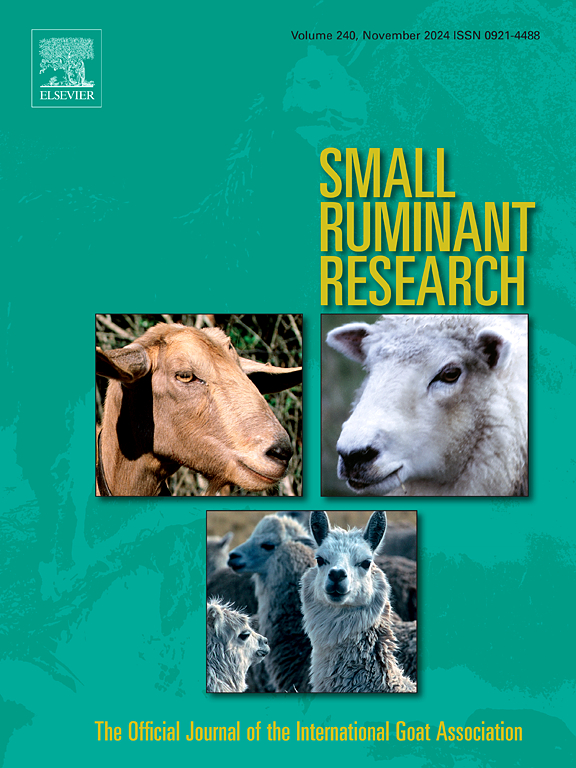Dose-response of Asparagopsis extract and diet quality effects enteric methane emissions for sheep fed high-forage diets
IF 1.6
3区 农林科学
Q2 AGRICULTURE, DAIRY & ANIMAL SCIENCE
引用次数: 0
Abstract
Asparagopsis spp. (Asparagopsis) receives considerable attention, due to the antimethanogenic properties it exhibits when included in diets of ruminant livestock. However, only one previous study has investigated the use of Asparagopsis in sheep in vivo, offered as part of a modified total mixed ration, reporting up to 80 % enteric methane (CH4) abatement at an inclusion of 3 % (organic-matter basis). The objective of this study was to investigate the interaction of bromoform (CHBr3) dose and basal diet quality on CH4 abatement in sheep, when fed a high forage basal diet with supplementary pellets containing CHBr3 extracted from Asparagopsis armata in oil (Asp-oil). Sixty merino wethers were used in a split plot design of five supplementary pellet treatments (100 g/d) of increasing CHBr3 concentrations (A0, 0 mg CHBr3/kg DM; A1, 36 mg CHBr3/kg DM; A2, 72 mg CHBr3/kg DM; A3, 108 mg CHBr3/kg DM; and A4, 144 mg CHBr3/kg DM) and fed either a high-quality (neutral detergent fibre (NDF) 40 %) or low-quality (NDF 55 %) forage basal diet. Wethers were housed in individual pens for 117 days to allow for measurements of feed intake and production parameters. Five measurements of CH4 production (MP, g CH4/d), 14 days apart, were conducted with open circuit respiration chambers. Wool growth (g/d), intake of basal diet and supplementary pellets (kg DMI/d), and average daily gain (kg/d) were production parameters. There was no significant interaction between diet × Asp-oil level on CH4 yield (MY, g CH4/kg DMI), but independently each had a significant effect. In comparison to their respective control (A0), A4 resulted in a 12 % and 19 % MY abatement for high-quality and low-quality diets, respectively. Average daily gain was significantly affected by diet (P < 0.001) but not Asp-oil inclusion. Wool growth rate was affected by diet (P = 0.05) only. This study has demonstrated that feeding sheep Asp-oil can reduced MP, regardless of diet quality. However, basal diet continues to influence MY. Future grazing trials are necessary to validate the results of this animal house experiment.
天冬酰胺提取物和饲粮质量对高粗饲粮绵羊肠道甲烷排放的量效效应
天冬酰胺受到相当多的关注,因为它在反刍家畜的饲料中显示出抗甲烷特性。然而,只有一项先前的研究调查了在绵羊体内使用天冬酰胺,作为改良的总混合日粮的一部分,报告了在含有3 %(有机物基础)的情况下,高达80% %的肠道甲烷(CH4)减排。本研究旨在研究在高饲料基础饲粮中添加从芦笋油中提取的CHBr3微球时,溴仿(CHBr3)剂量和基础饲粮质量对CH4减少的相互作用。60只美利诺羊采用分割区设计,添加5种增加CHBr3浓度的补充颗粒处理(100 g/d) (A0, 0 mg CHBr3/kg DM;A1, 36 mg CHBr3/kg DM;A2, 72 mg CHBr3/kg DM;A3, 108 mg CHBr3/kg DM;和A4, 144 mg CHBr3/kg DM),分别饲喂优质(中性洗涤纤维(NDF) 40 %)和劣质(NDF 55 %)的饲料基础饲粮。分别饲养117天,测定采食量和生产参数。在开路呼吸室中,每隔14天测量5次CH4产量(MP, g CH4/d)。羊毛生长(g/d)、基础饲粮和补充微球采食量(kg DMI/d)和平均日增重(kg/d)为生产参数。饲粮× Asp-oil水平对CH4产量(MY, g CH4/kg DMI)无显著交互作用,但各自独立影响显著。与各自的对照组(A0)相比,A4分别使高质量和低质量饲粮的MY降低了12 %和19 %。饲粮对平均日增重有显著影响(P <; 0.001),但对Asp-oil含量无显著影响。饲粮对羊毛生长率仅有影响(P = 0.05)。本研究表明,无论饲粮质量如何,给羊喂亚麻籽油都能降低MP。然而,基础饮食继续影响MY。未来的放牧试验是必要的,以验证该实验的结果。
本文章由计算机程序翻译,如有差异,请以英文原文为准。
求助全文
约1分钟内获得全文
求助全文
来源期刊

Small Ruminant Research
农林科学-奶制品与动物科学
CiteScore
3.10
自引率
11.10%
发文量
210
审稿时长
12.5 weeks
期刊介绍:
Small Ruminant Research publishes original, basic and applied research articles, technical notes, and review articles on research relating to goats, sheep, deer, the New World camelids llama, alpaca, vicuna and guanaco, and the Old World camels.
Topics covered include nutrition, physiology, anatomy, genetics, microbiology, ethology, product technology, socio-economics, management, sustainability and environment, veterinary medicine and husbandry engineering.
 求助内容:
求助内容: 应助结果提醒方式:
应助结果提醒方式:


